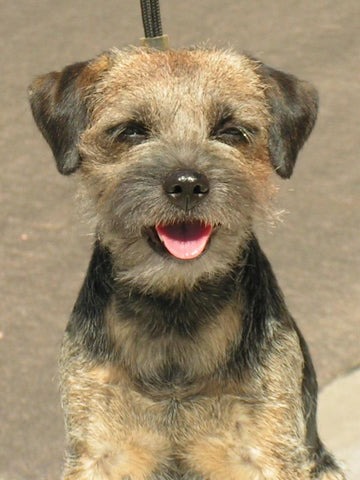
Border Terrier
Quick Facts:
- AKC recognized in 1930
- Lifespan: 12 – 15 years
- Size: Small
- Energy: Medium
- Recommended Crate Size: 24” | Small dog crate*
Return to main Dog Crate Size Breed Chart
Table of Contents
Introduction
The Border Terrier is a small-sized dog breed. In 2016, it became the 86th most popular dog breed, according to the American Kennel Club. Originally, this dog used to be known by two different names: Coquetdale Terrier and Redesdale Terrier. That was until the late 1800s when the name evolved again into the Border Terrier.
There is a story behind this name. The origins of the Border Terrier starts in the Cheviot Hills in Great Britain. The hills form a border between two countries, England and Scotland.
That area is full of foxes terrorizing the farmer’s stock and Shepherd's sheep. To hunt and kill those foxes, the people needed a dog whose legs are long enough to follow them.
The dog would need to be tireless, strong and able to withstand the mists and rains. The Border Terrier met all the criteria they needed. That’s why you will see a lot of them living in the homes in this region.
In addition, its small body enables it to chase its prey down to the narrowest hole. Even today people still have this dog for the same purposes, which is hunting foxes as well as other animals like otters, badgers, and rodents.
Breed
The American Kennel Club formally recognized the Border Terrier in 1930. These medium energy dogs are known as friendly and affectionate. They rarely show their aggressiveness and are suitable for living with children. What’s more, they are quite easy to train, with the ability to learn some tricks quickly.
The only issue pet owners will have to deal with is that they have an innate instinct to dig. This makes sense since they were bred to hunt foxes which live in underground. The Border Terrier is not an excessive barker, but they may make themselves known when someone comes to your house.
Appearance
The Border Terrier is well-known for their unique head which resembles an otter. They have a flat and broad skull with a couple of V-shaped ears falling toward the side of their cheeks.
Their tail is moderately short, tapering, and thick at the base. The common colors for their coat are red, blue and tan, grizzle and tan, or wheaten. Males Border Terriers can weigh around 13-15.5 pounds, while females range between 11.5-14 pounds.
Nutrition
It is recommended to provide feed formulated to small-sized breeds. It is highly recommended to discuss your dog’s feed with your veterinarian and/or breeder in order to determine the size and frequency of meals in order to ensure a healthy, long life. It is also important to ensure that clean, fresh water is always available.
Grooming
The Border Terrier does not require a lot of maintenance. There is no need to give them frequent bathing, for example. Wiping them with a wet towel is often enough to clean them. Furthermore, their weatherproof coat only requires brushing and hand stripping twice per year.
Exercise
Since the Border Terriers is quite active, let them walk outside and explore. If they do not have a large backyard, take them for daily walks. They are also good playmates with children during outdoor activities.
Pet Crate Size
Pet Crates Direct recommends 24” dog crates* for most adult Border Terriers.
* Links for crate sizes will bring you to the most appropriate Amazon page.



